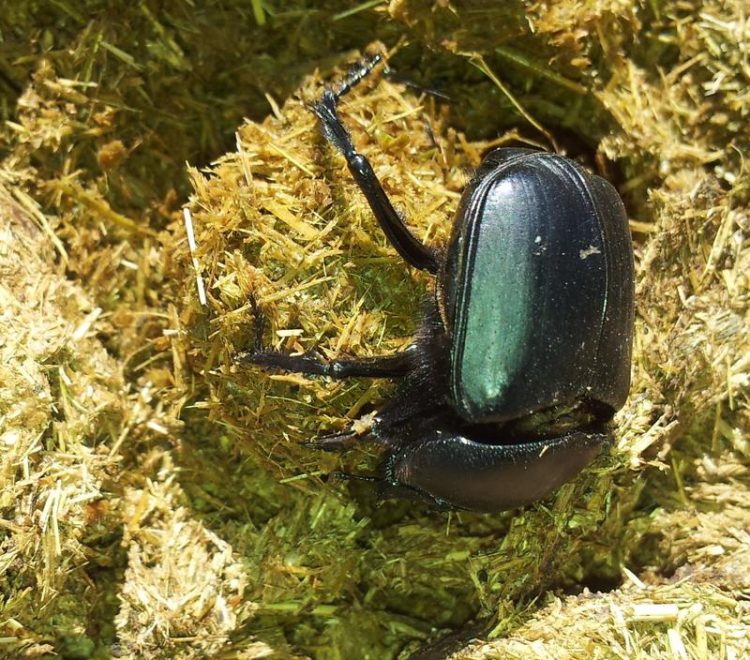Angiosperm plants and mammal dung – food for evolution

A typical species of the genus Scarabaeus rolling a pill. copyright: Dr. Dirk Ahrens, ZFMK, Bonn
Dr. Dirk Ahrens, Dr. Julia Schwarzer and their colleague Prof. Alfried Vogler reconstructed a phylogeny of scarab beetles, which include stag beetles, dung beetles and chafers. The researches dated the different lineages using fossils and a molecular clock.
The researchers showed that plant-feeding chafers, which are among the most diverse beetle groups in the world, arose almost immediately after the origin of the angiosperms in the Middle Cretaceous. The same lineage also gave rise to dung beetles, but they originated much later, and only after the mammals, including the even-toed ungulates (Artiodactyla) as the most important herbivores, had themselves started to use the angiosperms as their food source. The late origin of dung feeding rejects the widely held hypothesis that early dung beetles fed initially on dinosaur dung, which already were extinct by that time. Instead, the evolution of angiosperm plants provided a new resource that first enabled the origins of herbivory in mammals and beetles, and secondary dung feeding among the scarab beetles.
However, the researchers still try to unravel the mystery of why there are so many species of chafers. In contrast to other plant feeding insects, chafers are not specialised on certain plant species. It might thus be possible that the copious leaf litter produced by the angiosperms created highly suitable conditions for these beetles and their soil-dwelling larvae.
Contact:
Dr. Dirk Ahrens
(Abteilung Arthropoda)
Zoologisches Forschungsmuseum Alexander Koenig
Adenauerallee 160
53113 Bonn
Germany
Tel.: +49 (0)228 9122 286
Fax: +49 (0)228 9122 212
E-Mail: d.ahrens@zfmk.de; ahrens.dirk_col@gmx.de
http://www.zfmk.de/web/ZFMK_Mitarbeiter/AhrensDirk/index.de.html
The paper and any related press releases are made available – under embargo – to the media via a password protected press site. This press release will also be made available to journalists on the Royal Society’s press site.
Ahrens D, Schwarzer J, Vogler AP. 2014 The evolution of scarab beetles tracks the sequential rise of angiosperms and mammals. Proc. R. Soc. B 20141470.
http://dx.doi.org/10.1098/rspb.2014.1470
ZFMK: Zoologisches Forschungsmuseum Alexander Koenig – Leibniz-Institute for animal biodiversity is part of the Leibniz Association, a network of 89 scientifically, legally and economically independent research institutes and scientific service facilities. Leibniz Institutes perform strategic- and thematically-oriented research and offer scientific service of national significance while striving to find scientific solutions for major social challenges. More information: http://www.leibniz-gemeinschaft.de/
For more information visit: http://dx.doi.org/10.1098/rspb.2014.1470
Media Contact
All latest news from the category: Earth Sciences
Earth Sciences (also referred to as Geosciences), which deals with basic issues surrounding our planet, plays a vital role in the area of energy and raw materials supply.
Earth Sciences comprises subjects such as geology, geography, geological informatics, paleontology, mineralogy, petrography, crystallography, geophysics, geodesy, glaciology, cartography, photogrammetry, meteorology and seismology, early-warning systems, earthquake research and polar research.
Newest articles

First-of-its-kind study uses remote sensing to monitor plastic debris in rivers and lakes
Remote sensing creates a cost-effective solution to monitoring plastic pollution. A first-of-its-kind study from researchers at the University of Minnesota Twin Cities shows how remote sensing can help monitor and…

Laser-based artificial neuron mimics nerve cell functions at lightning speed
With a processing speed a billion times faster than nature, chip-based laser neuron could help advance AI tasks such as pattern recognition and sequence prediction. Researchers have developed a laser-based…

Optimising the processing of plastic waste
Just one look in the yellow bin reveals a colourful jumble of different types of plastic. However, the purer and more uniform plastic waste is, the easier it is to…



